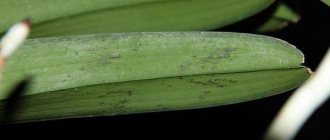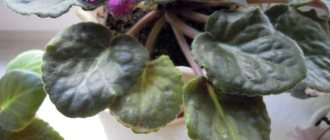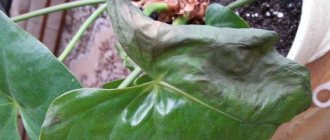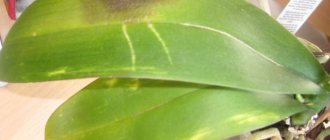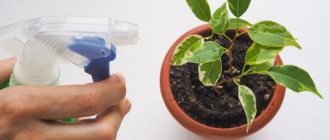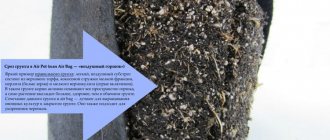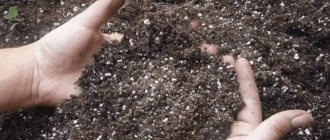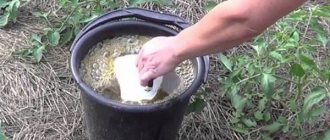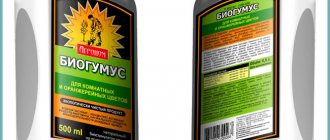Very often, when growing indoor plants, you can make several mistakes and your plant begins to look bad and get sick. By disrupting the growth and development of a plant, many diseases of indoor flowers can be provoked.
There are many reasons that cause similar symptoms, and if you assume that this is the effect of a draft, you may miss the onset of the development of certain health problems for your indoor plants. The most common problem is houseplant diseases - sticky leaves, and these can also be dealt with.
When choosing medications, you can use proven products, such as potassium permanganate; boric acid for indoor plants is used more for feeding than in the fight against diseases of domestic flowers.
The most common diseases among indoor plants is powdery mildew, which is divided into downy and true. Gray rot, root rot, brown rot of the root collar, fusarium, rust, leaf spot, sooty fungus. If they are not detected in time, then these problems are difficult to solve without special medications.
Powdery mildew
Powdery mildew
It is provoked by ectoparasitic fungi, which, when they get on a leaf, multiply quite quickly and increase the affected area. It appears in the form of a white persistent coating, which is located on the leaf part and on the fruit. The disease itself is practically harmless. Its consequences are dangerous. A long-term fungal infection significantly weakens the immune system, which makes it possible for a secondary disease to occur.
Often, against the background of powdery mildew, rot and other fungal infections form. Roses, pumpkin plants, and Rosaceae are susceptible to the disease. Among indoor flowers - ficus. To prevent the development of fungus, it is necessary to carry out preventive spraying with antifungal drugs: Fundazol, Vitaros, Topaz.
The most effective ways to combat powdery mildew without chemicals are spraying with baking soda. To do this, stir 1 teaspoon of soda in a glass of warm water and spray it throughout the plant through a spray bottle. To improve adhesion, you can add half a teaspoon of liquid soap (tar tar is best). Powdery mildew will not appear on roses if spraying is done 2 times a month starting in April.
Downy mildew
Downy mildew
The disease is provoked by the same fungi, but the distinguishing feature is the location of the mold. A thick white coating forms on the inside of the leaf, which may not be visually noticed for a long time. As the fungal infection grows and develops, orange spots form on the surface of the leaf blade, which lead to curling of the leaf, but do not cause them to fall off.
In the fight, the remedy Fundazol has proven itself well, which is used for crops of any kind, including trees. Most often, those specimens that get sick are those that are watered with cold water.
Fleas (boogers)
Various small flea beetles (cruciferous, potato, light-legged, beet, etc.) are part of the family of leaf beetles and, as the name implies, actively damage the leaves of various agricultural crops, including at the seedling stage.
Both adult insects and their larvae in the leaves through holes, often before the leaf blades become skeletonized. The larvae also eat thin plant roots. When multiplying en masse, insects will completely destroy tender seedlings in just a few days.
It is necessary to fight the mediator comprehensively. In the fall, dig up the soil deeply: insects overwintering in the upper layers of the soil, once on the surface, will not survive at low temperatures.
Observe sowing dates and crop rotation. In the spring, next to the seedlings, grow plants that produce phytoncides (garlic, nasturtium, marigolds, calendula, caraway, etc.), they will repel the flea.
Kill weeds.
Dust green crops “infested” with flea beetles with a mixture of wood ash and tobacco dust (1:1), ash and slaked lime (1:1). Various infusions can also be used against the pest: tobacco, vinegar, dandelions or a decoction of potato tops.
If we are talking about chemicals, good results can be achieved with the help of Aktara, Alatar, Aliot, Karbotsin, Fufanon-Nova.
- Cruciferous flea beetles - how to fight and win
These jumping insects can ruin almost your entire cabbage and radish harvest, as well as ruin the appearance of your roses and lilies!
Scab
Elena Stanislavskaya
I know everything and a little more about ornamental plants. I bring everything new and most interesting to life, creating unique landscape compositions and green oases in the house.
Ask a Question
This disease has collective symptoms and has its own pathogens for each plant species. It appears in the form of growths, tubercles or dents on fruits and trunks, which lead to deformation. Most often, potatoes, apples, pears, tomatoes, eggplants, peppers, and rosaceae are affected.
Scab
In the fight against scab, it is important to recognize it in a timely manner. If the slightest signs appear in the form of growths, preventive spraying should be carried out. You can choose a store-bought remedy for scab, which has a complex effect on the plant and prevents relapse. The available and safe options for combating the disease include the following:
- Spraying with mustard and ash - for 1 liter of hot water, take 1 tablespoon of mustard powder and 2 tablespoons of wood ash. Leave to brew for a day, then mix well and spray the entire above-ground part of the plant. The frequency of prevention is 4 times per season;
- Potassium permanganate and boric acid - for 1 liter of hot water, take no more than a match head of potassium permanganate powder and the same amount of boric acid powder. The result is a saturated purple solution, which is poured into a five-liter bucket, 1 tablespoon of iodine is added and flowers, shrubs and fruit trees are treated.
Scab treatment in spring is especially necessary for garden crops. Trees and shrubs should be sprayed with boiling water with the addition of 1 tablespoon of table salt per liter of water.
Necrotic spot virus
This disease affects indoor and ornamental plants, such as: African violet, dracaena, petunia, gerberas, sage, lilies, balsam, nasturtiums.
Necrotic spot virus
How did the infection occur? The virus is found in water, but can also live in soil. At risk are those plants that have weakened immunity and are watered with cold, unsettled water.
How does it manifest? Holes form in the leaf, which leads to its complete withering. Holes are preceded by fading of individual sections of the sheet and its curling.
How to help? The affected leaves are removed, and the plant is generously sprayed with special solutions containing antiviral agents. Copper sulfate has proven itself well. Watering with warm, settled water with the addition of 1 drop of iodine per 1 liter of water helps prevent the disease.
Ascochyta blight
Ascochyta blight
The disease is caused by the activity of fungi of the genus Askochita, which are found in large quantities in the soil. It appears in cereals, pumpkins and even citrus fruits. As for flowers, asters and chrysanthemums are most honored by fungi. The reasons for the development are:
- waterlogging of the soil (improper watering, prolonged downpours);
- excess nitrogen in the soil;
- sudden changes in temperature;
- dense plantings.
Ascochyta blight manifests itself in the form of fading of part of the leaf blade (like a sunburn), which quickly spreads to other areas. A completely affected flower dries out, and characteristic rot is present on the roots.
If the disease has affected most of the plant, then, no matter how sad it may sound, you will have to get rid of it. Ascochyta leaves are removed, and spraying with fungicides is used to prevent the entire flower from wilting. The means at hand are practically powerless, so preference is given to Bordeaux mixture and Topaz.
Advice! After the main etching, it is necessary to do preventive etching after 10-14 days. This way the result will be consolidated and the remnants of the mycelium will completely die, which will prevent the development of new foci of infection.
Forecast, protection and treatment of viral plant diseases
Unfortunately, there are no effective drugs against viral infection of plants, so the diseased plant is isolated, its damaged leaves and cuttings are cut off. If after this the flower does not get better, it will have to be destroyed, and all transplanting equipment should be treated in the oven or wiped with alcohol.
Bacteriosis
Bacteriosis
- this is a large group of diseases caused by tiny phytopathogenic bacteria that infect the plant through the stomata or conducting system - roots, vessels. Bacteria are also transmitted through seeds, cuttings, and contaminated soil. Their survival depends on conditions - temperature, the presence of plant-friendly microorganisms with phytopathogenic activity, humidity. The spectrum of manifestations of bacteriosis is wide - from local burns and spots to rot, necrosis and complete wilting.
Wet rot
is caused by bacteria of the genus Pseudomonas and appears as wet yellowish or brown spots with uneven outlines and a rotting smell. Species with dense, elastic shoots and leaves, such as orchids, are susceptible to infection. The appearance of the disease is associated with excess moisture and nitrogen in the soil.
leaf affected by white spot
spotting
(dotted, ringed, spots of irregular shape) produce watery spots that do not have clear boundaries, which gradually turn brown or black.
It is worth distinguishing between fungal and bacterial spots; fungal spots often form a pattern of concentric circles and tiny dark dots. Sometimes the spotting looks like a charred burn on the upper leaves. In warm conditions and when the soil does not dry out for a long time, the disease progresses faster. Bacterial cancer
is a recognizable disease, often occurring in a cold, damp room, and begins with the formation of cracks, deformation, after which tumor-like growths appear on the roots and shoots. Carried by contaminated soil, grafting material or pests.
Bacteria affect: begonias, violets, Kalanchoe, succulent spurge, bulbous, tuberous plants.
Anthracnose
Anthracnose
Anthracnose is a group of fungal diseases that have different pathogens (imperfect fungi), but exhibit similarities in symptoms and course characteristics. Appears on orchids, garden and indoor plants, as well as shrubs and fruit trees. The causes of the disease are:
- excess nitrogen in the soil;
- increased alkalinity;
- deficiency of potassium and phosphorus;
- injuries to the green part of the leaf and the entry of fungal spores into the wounds.
Fungal bacteria in plants are spread by wind and insects, so if the first signs of anthracnose are present, treatment should be started immediately. The disease can be recognized by the following signs:
- spots on sheets that turn black over time;
- deformation of the leaf plate and stem;
- slowing down plant growth.
If appropriate measures are not taken in a timely manner, there is a risk of complete death of the plant, as well as the spread of bacteria to healthy crops growing in the immediate vicinity.
Treatment involves removing diseased leaves, as well as treating them with special fungicidal agents. Of the available options, anthracnose can be treated with Furacillin tablets. To do this, grind 2 tablets into powder and pour a glass of hot water. Mix well until completely dissolved, then spray the green part and spill the soil around it.
Features and manifestations
Gerashchenko Anna
Florist with extensive experience. The mistress of pelargoniums, the mistress of cacti and the owner of the botanical garden on the windowsill.
Ask a Question
Plant pests are not just bugs, spiders, and caterpillars. Viruses that are found in soil, air and water are microscopic in size, which allows them to easily penetrate inside the plant. As soon as this happens, visual changes appear that are extremely difficult not to notice. If the gardener ignores the first “bells”, attributing the spots on the leaves to sunburn, there is a risk of the viral infection quickly spreading to the entire plant, which will inevitably lead to sudden death.
The primary symptoms of plant diseases caused by viral cells are as follows:
- Spots on the surface of the leaf that quickly increase in diameter;
- Wilting of the leaf part and blackening of the trunk;
- Leaf fading, lack of rich green color;
- Sharp inhibition in growth and development;
- Lack of positive reaction to feeding.
It is not easy to recognize the virus by its manifestations, since it can masquerade as many other causes. Bacterial plant diseases often accompany viruses, since the latter significantly deplete the immune system, making it impossible to resist bacteria.
You can read about fungal infections of plants here.
Septoria
Septoria
It is provoked by the activity of primitive fungi of the genus Septoria, which affect phlox, anthurium and many garden crops. The causes of the development of the disease are waterlogged soil and watering with cold water, which weakens the immune system and does not allow the plant to resist infection using the natural defenses of the plant.
Symptoms of the disease are small dark yellow spots, which over time spread along the leaf and lead to its drying out and natural falling. A characteristic feature is the pink iris that forms around the spots.
In treatment, only complex fungicidal preparations are used, since improvised means are ineffective in most cases.
How to resuscitate at home?
If you are infected with a fungus, proceed as follows:
- remove diseased parts of the plant, repeat the procedure until signs of fungal infection disappear;
- carry out fungicide treatment according to the instructions. You can use “Skor”, “Bravo”, “Topaz”, “Previkur”;
- spray the plants with 1% Bordeaux mixture every 7 days.
It is important to get rid of factors that provoke the development of fungi. These include:
- high humidity;
- temperature that is not optimal for the flower;
- improper feeding.
How to get rid of rust on leaves?
When rust appears, it is necessary to treat the plant with 1% Bordeaux mixture. Fungicides you can use:
- Topaz;
- Abiga Peak;
- Baktofit;
- Fitosporin-S.
Proper care will help increase the effectiveness of treatment. The plant is moved to a warm, dry room. You need to choose a well-lit place or organize lighting and regular ventilation. The number of waterings is reduced, providing the flower with the necessary minimum of moisture.
Memo. For infectious and parasitic diseases, treatment with special preparations alone is not enough. You need to repeat the procedure at least one more time - after 7-14 days. The exact period can be read in the instructions for the drug.
Treatment of other diseases
To combat infectious diseases, special drugs are used:
- Fungicides help control fungi;
- When infested by insects, insecticides are used.
Bacterial infections do not cause plaque, although spots may appear. They are characterized by other symptoms: swelling, softening and peeling of tissue. For treatment at an early stage, the affected parts are removed. Some gardeners use spraying and watering with Trichopolum. Severely affected flowers cannot be saved.
Viral infections lead to mosaic-shaped spots or yellowing of leaves. There is no treatment. You can try to save the plants by removing the affected parts. After trimming, it is necessary to sterilize the instrument. If the flower cannot be saved, it is thrown away along with the soil. The pot is thoroughly washed and disinfected.
On a note. It is easier to prevent any disease than to treat it. Therefore, preventive measures should be observed.
Plant rust
Plant rust
Rust is caused by a large class of primitive fungi, the spores of which have a rich orange hue. Any garden crops are affected. In rare cases, the disease can manifest itself in representatives of indoor plants, which indicates improper feeding and lack of soil disinfection before planting.
Rust appears in the form of bulges on an orange leaf, upon contact with which pollen is released. Bacteria are spread by wind and insects, so experts recommend preventative treatments in the spring that will help prevent infection of all plants in the garden.
Plant rust
To combat the disease, spraying with Bordeaux mixture is used in early spring. When rust forms on indoor flowers, use appropriate fungicides.
Pests of indoor plants and their control
Determining pest damage to flowers is more difficult than preventing their appearance.
And although pests attack indoor flowers less often than their garden ornamental brothers, they sometimes have a more difficult time, because the immunity of house plants is lower, and due to crowding, pests travel freely through indoor “beds”, quickly infecting healthy specimens. The most common sign of pests is sticky leaves. An unpleasant sticky coating is the secretion of sucking pests. The products of their vital activity stick to the leaves, preventing the plant from breathing; the flower slowly dehydrates and becomes easy prey for pathogenic microorganisms.
Here are the most common types of pests of indoor and garden ornamental plants:
whitefly adults and larvae
Kivsyak
Mealybug
Whitefly adults and larvae
Tracheomycosis wilt
It is provoked by fungi of the genus Fusarium and Verticillum. The disease is accompanied by the development of root rot, which in the shortest possible time leads to complete withering of the plant. The following factors provoke the development of wilting:
- Infection of the soil with purchased seedlings or infected seeds that have not undergone pre-sowing treatment;
- Excessive watering and rainy summers;
- Presence of other diseases.
Tracheomycosis wilt
Often tracheomycosis wilt develops as a secondary infection when the plant already has diseases that burden the immune system. Any crops and shrubs are at risk, but indoor violets, dollar trees, and orchids are most often susceptible to wilting.
In most cases, wilting cannot be stopped. The plant dies quite quickly. At the first signs of the disease, when apparently healthy leaves droop and lose their elasticity, treatment is carried out with a weak solution of potassium permanganate (soil and above-ground parts). Soda has proven itself to be good for fading. Its solution allows you to fight rot in the garden and on the windowsill.
We also have articles about viral and bacterial plant diseases.
Question to the expert
What is root rot?
There are several reasons for the appearance of root rot. The main thing is that the root system remains in water for quite a long time due to excessive watering. This situation leads to a lack of oxygen, and, as a consequence, the death of the root system, followed by rotting and falling off. Rot can first affect individual roots and then spread to healthy roots. This also happens when watering the plant has already stopped.
The second reason is the presence of pathogenic fungi in the soil. It is worth noting that such fungi will remain passive in the ground for an unlimited time. But as soon as the flower is watered, the fungi begin to multiply quickly. The end result is the same: death and rotting of the roots.
How to recognize root rot
At first, your home flower grows well and pleases you with its blooms. But at one point you begin to observe the slow withering of the leaves, yellowness appears on them and they become lifeless. Where do you need to start? Check the roots of the plant for their viability.
How to find out whether the roots are affected by root rot or not? It is worth carefully removing the plant from the pot and touching the roots. If this disease is present, the roots will be black and softened. Affected roots will fall off when touched. But not all roots can get sick. Among the painful ones, you can identify completely healthy specimens that are pale or black in color, but flexible and hard to the touch.
Pathogens of root rot
They can be various pathogenic fungi, which include Rhizoctonia, Pythium, Phytophthora and many other representatives of this genus. They first attack the roots, and the effects of the diseases are reflected on the leaves and stems. Serious pathogens can completely destroy young plants (seedlings, cuttings, saplings) in literally a matter of days. The roots and bottom of the stem rot quickly enough. Even the leaves do not have time to turn yellow.
Black rot is also called “black leg”. Saintpaulia, orchids, succulents and cacti, and pelargonium are most susceptible to such infection. The main reason for the defeat is improper implementation of agrotechnical measures. The presence of pathogens leads to blackening of the root system as a whole or a separate part of it, as well as to their softening. Black rot appears when there are dense earthen lumps in pots, which contribute to the formation of a constant aerobic environment around the roots. The source of infection can be the pots themselves, poor-quality soil mixtures, equipment, undisinfected seedling boxes that once contained diseased plants.
How to prevent diseases?
To prevent powdery mildew on indoor plants and other diseases of fungal and bacterial flora from causing harm, preventive treatment is recommended. The inhabitants of the window sill need to spray and spill the soil with water and hydrogen peroxide dissolved in it. This composition protects against many fungi, increasing plant immunity.
Soda has proven itself well in the garden. Spraying allows not only to destroy existing lesions, but also to prevent possible diseases. The garden is cultivated in early spring, after the leaves have been harvested. Repeated disinfection is performed after a month. If the weather is rainy, then spraying should be done once every 2 weeks.
List of drugs
Consento
Consento is an effective systemic fungicide for the control of late blight, Alternaria and peronospora, available in the form of a suspension. The product has unique activity against a large number of fungi that infect seeds, seedlings, leaves and fruits of plants, and also has a preventive and therapeutic effect. Easy to use: the drug is diluted with water according to the instructions and sprayed evenly until the leaves of the plant are completely wetted. Begins to act from the first day after treatment.
Abiga Peak
This is a chemical from the group of contact fungicides. It is based on copper oxychloride. This element, when released, directly affects the vital activity of the fungus, slowing down the processes of its growth and respiration. Copper also prevents the synthesis of important proteins, which also kills the fungus.
Acrobat MC
This is a drug with a systemic contact type of effect.
Its active components are the chemicals dimethomorph and mancozeb. It comes in the form of granules that dissolve in water.
Gardeners use it to combat late blight, Alternaria and other diseases.
This natural product contains strains of bacteria Bacillus subtilis.
It can be found commercially in tablet or powder form.
"Alirin-B" is used to treat diseases such as late blight, powdery mildew, scab, gray rot and many others. This fungicide affects the vital processes of the fungus, suppressing them. Positive side effects include an increase in the amount of ascorbic acid and a decrease in the amount of nitrates in the crop.
It can be used to treat plants or as a prophylactic agent to protect plants from pathogenic fungi.
Byleton
Chemical fungicide, the active substance of which is triadimefon. Available in powder form. Differs in systemic action.
It will help cope with fungal diseases such as powdery mildew, fucariasis, rust, septoria and many others. Triadimefon in this fungicide inhibits the growth of the fungus and also disrupts the synthesis of compounds necessary for the fungus. Thus, this drug helps fight diseases.
Bordeaux mixture
This is a broad-spectrum fungicide designed to protect a wide variety of crops from fungal infections. It is quite effective and safe for plants. The solution is quite simple to prepare; it stays on the plants for a long time, without losing its potency.
Available in the form of a water-soluble powder.
Vitaros
This is a contact-systemic drug intended for treating seeds before planting.
Available in the form of a solution in ampoules. The main active substance is thiram + carboxin.
Lasts for a long time. The preparation contains a dye, which facilitates the processing process.
Gamair
This biological fungicide is based on colonies of Bacillus subtilis bacteria. It is used to exterminate fungi both on plants and in the ground. In terms of action, it is an analogue of another fungicide - “Fitosporin”.
Gamair is commercially available in the form of tablets and powder.
This fungicide is used both to successfully combat pathogenic fungi and bacteria, and to prevent diseases in garden and indoor crops.
Glyocladin
This fungicidal drug is an analogue of another - trichodermin. This drug is made based on the culture of the fungus Trichoderma harzianum, as well as bacteria that have a positive effect on the soil. "Glyokladin" fights fungi in the soil, preventing plant infection. The fungal culture in this fungicide multiplies in the soil, thereby suppressing the growth of pathogenic fungi and bacteria. The fungal culture itself is harmless to plants; it is destructive only to pathogenic organisms.
This drug can be found on sale in tablets and also in the form of suspensions.
The positive properties of this drug also include the fact that it is safe, can restore the soil, and is also highly effective. "Glyokladin" is able to cleanse the soil of harmful chemicals after the use of pesticides.
Green soap
This is a natural fungicide made from vegetable oils and animal fats, as well as potassium salts of fatty acids. Although it is called “Green Soap”, this preparation is not soap, but only consists of the same components as real soap.
This drug is used by gardeners to prevent the appearance of fungi and harmful insects on plants. After treatment, it covers the leaves and branches of the plant, like a film, preventing pests and fungi from multiplying on it.
Based on “Green Soap”, various solutions for treating plants are made at home.
Green soap should only be used for spraying plants; it is not recommended to apply it to the soil.
Kurzat
The effectiveness of the action is ensured by the main substances - copper oxychloride and cymoxanil.
Copper oxychloride works from the inside, covering the plant with a protective layer, preventing infection by fungi and pests. Cymoxanil, on the contrary, acts from inside the plant, quickly spreading throughout the plant and destroying the fungus.
Together, these two components provide effective treatment and plant protection. The drug suppresses the proliferation of the fungus, disrupts its vital functions, and also has an antibacterial effect.
"Kurzat" is mainly used to combat late blight and powdery mildew.
Sold as a water-soluble powder.
Maksim
This drug is from the group of contact fungicides. Gardeners use it to treat bulbs and tubers before planting, and it also helps prevent bulbs from rotting during storage.
The active substance of this fungicide, fludioxonil, is very similar in composition to antibiotics. It kills pathogenic fungi and soil microorganisms without affecting beneficial soil microflora in any way.
Protects crops from scab, various rots, blackleg and other diseases.
Oksikhom
Fungicide of contact-systemic action. Sold in powder form, used for spraying plants. Made from copper oxychloride and oxadixyl. It is used to successfully combat late blight, macrosporiosis, and peronosporium on plants both in the garden and in the apartment.
It has a very fast action, the effect is visible after a couple of hours. That is why it is recommended to be used to treat advanced cases of fungal diseases.
It is important to remember that Oxychom cannot be combined with other fungicidal drugs. It is a toxic drug, so plant treatment must be carried out at least 20 days before harvest.
Ordan
A complex drug that has both systemic and contact effects. It is based on copper oxychloride and cymoxanil. Due to the combination of these components, “Ordan” performs several tasks at once: copper oxychloride is responsible for eradicating fungus and also has a bactericidal effect; Cymoxanil treats the plant and also protects them from re-infection.
One of the distinctive features of this product is that it is not addictive to fungi. Pathogenic organisms cannot adapt to this drug, which is why it is always effective.
Previkur
The spectrum of action of Previkura is quite wide. It helps to cope with peronosporiasis, various types of root rot, as well as other fungal diseases. Its main difference from other fungicides is its ability to act as a plant growth stimulator. It affects the plant immune system and protects against subsequent infections. It is used for both garden crops and indoor flowers.
Profit Gold
Fungicide with a systemic mechanism of action. Its two active ingredients, cymoxanil and famoxadone, provide effective treatment for various fungal infections. Cymoxanil penetrates the plant and acts on the fungus from the inside, blocking its development. And the second component is responsible for influencing the fungus from the outside. Famoxadone kills the fungus and its spores, and also forms a thin film over the plant. It is this systemic action that helps to quickly and effectively combat fungus on plants, even in difficult cases. The effect of the drug is long-lasting.
Gardeners use Profit Gold to combat late blight, powdery mildew, anthracnose and other fungal diseases. This fungicide is also used to treat and protect indoor flowers.
Rayok
This drug is similar in action to the drug "Skor". "Rayok" is absorbed by plants, so it makes it easier to fight diseases. Another advantage of this drug is that it begins to act very quickly, literally within a few hours. It is also resistant to being washed away by rain.
The basis of this fungicide is difenoconazole. This substance directly affects the synthesis of the genetic material of the fungus and disrupts it. Because of this, the fungus gradually dies.
Cures garden trees and other plants from scab, Alternaria and powdery mildew.
It is commercially available as an emulsion.
Ridomil gold
Quite effective contact fungicide. Two active ingredients, mefenoxam and mancozeb, effectively fight the fungus, protecting the plant both outside and inside.
Mefenoxam penetrates the plant tissue, reaches the lesion and destroys the fungus. Mancozeb comes to his aid, acting outside the plant, enhancing the effect of the first active substance. Together they quickly help get rid of the disease.
This fungicide is effective in the fight against late blight, peronospora, and also copes well with downy mildew. Quickly decomposes in the soil without harming beneficial organisms.
This drug is produced in granules, they are dissolved in water and a solution is obtained for spraying plants.
Rovral
This is a contact fungicide intended for the local treatment of fungal diseases. The affected areas are lubricated with the drug solution. You can also water the ground with it before planting plants.
Mechanism of action: the active substance iprodione stops the reproduction and germination of spores, and also negatively affects the development of the fungus.
This fungicide is effective against verticellosis, fucaria, late blight, and powdery mildew in various garden and garden crops.
"Rovral" can be used in small doses for preventive treatment of plants. It is also recommended to treat seeds before long-term storage.
Available in powder form.
Score
"Skor" is used for the treatment and prevention of scab, powdery mildew, various types of spots, moniliosis, coccomycosis.
This fungicide can be used to treat plants in all phases of development.
The big advantage of this drug is its speed of action.
It can be found on sale in the form of an emulsion.
Topsin-M
The active ingredient of this fungicide is methyl thiophanate. Spreading throughout the plant, this component stops the growth of the fungus and also blocks the processes of sporulation.
Penetration into the plant occurs through the root system.
In addition to fungi, it also destroys insect pests (for example, aphids), as it also has an insecticidal effect.
The positive aspects of this drug also include: speed of action; the ability to use this drug both for the treatment and prevention of fungal diseases; efficiency; safety for people and plants.
This drug will work better and faster if it has already been used previously as a prophylactic agent.
Available in the form of an emulsion, as well as a water-soluble powder.
Trichodermin
This is a biological fungicide made from natural ingredients. It has become an excellent alternative to chemical pesticides.
This drug is based on a strain of saprophytic fungi Trichoderma lignorium. This fungus, when it gets on the substrate, begins to actively grow and multiply. In the process of its life, it releases special substances - natural antibiotics. These substances have a negative effect on the harmful fungus, leading to its death.
Other positive qualities of the drug also include the fact that it is completely safe for people and animals, does not accumulate in fruits, and is also able to increase the amount of harvest. In addition to fighting fungi, it has a beneficial effect on the soil and also accelerates plant growth.
The effect of the drug is quite long - it lasts about a month.
"Trichodermin" is effective against more than fifty different pathogens of fungal diseases.
Available in powder and suspension form.
Fitosporin-M
This natural fungicide is made from the bacteria Bacillus subtilis. Antibiotics secreted by these bacteria have a detrimental effect on pathogenic fungi that have infected your plants.
Effective against many fungal diseases, including black rot, rust, root rot, late blight and many others.
It is practically non-toxic, which allows it to be used for treating indoor flowers. Its additional effect is to stimulate plant growth.
Available in three forms - powder, paste, solution.
Hom
This fungicide is based on copper oxychloride.
Can act as an analogue of Bordeaux mixture. But the main difference from it (unfortunately, negative) is that “Hom” is very easily washed off with water from plants, so it is not durable.
Used to combat late blight, peronosporosis, spotting.
Mechanism of action of the drug: after treating the plant, the drug reaches the foci of fungal infection and penetrates their cells. There, the fungicide affects the synthesis of substances important for the fungus, and this causes the death of the fungus.
This fungicide is not addictive to pathogenic organisms, so it is always effective in combating them.
Horus
"Horus" is a fungicide with a systemic type of action. It is based on cyprodinil.
Designed for spraying crops; after treatment, it forms a thin layer on plants that protects them from infection.
It is used for the treatment and prevention of diseases such as scab, coccomycosis, moniliosis, leaf curl and some others.
The advantages of the drug also include the fact that it is active at low temperatures, non-phytotoxic, economical, and easy to use.
Here is a list of most fungicides used to treat and protect plants from fungal diseases . After reading it, you will have an idea of what fungicides are, how they can help your plant, and which fungicide is best to choose to save your plants.
Physiological
Sometimes the cause of illness in indoor flowers is not fungi or viruses at all, but simply improper care! Some plants react quickly to errors in care, others forgive minor mistakes, but almost all flowers, if the conditions of maintenance are systematically violated, begin to get sick. Unlike the previous ones, this group of diseases is not contagious!
Dropsy
Externally, the signs of the disease look like watery pimples. The formations are usually located on the inside of the leaves, so they are not always noticeable. The reason for this phenomenon is excessive watering in low light conditions.
Risk group : hibiscus, ficus, pelargonium, peromnia, Kalanchoe, citrus fruits.
dropsy
Treatment. Unfortunately, the affected leaves cannot be restored, so they will have to be removed in the future. First of all, reduce watering, provide the plant with more diffused light, or compensate for its lack with artificial lighting. The pot must have holes and a tray so that excess moisture does not linger! Also, don't forget to put a layer of expanded clay on the bottom of the pot.
